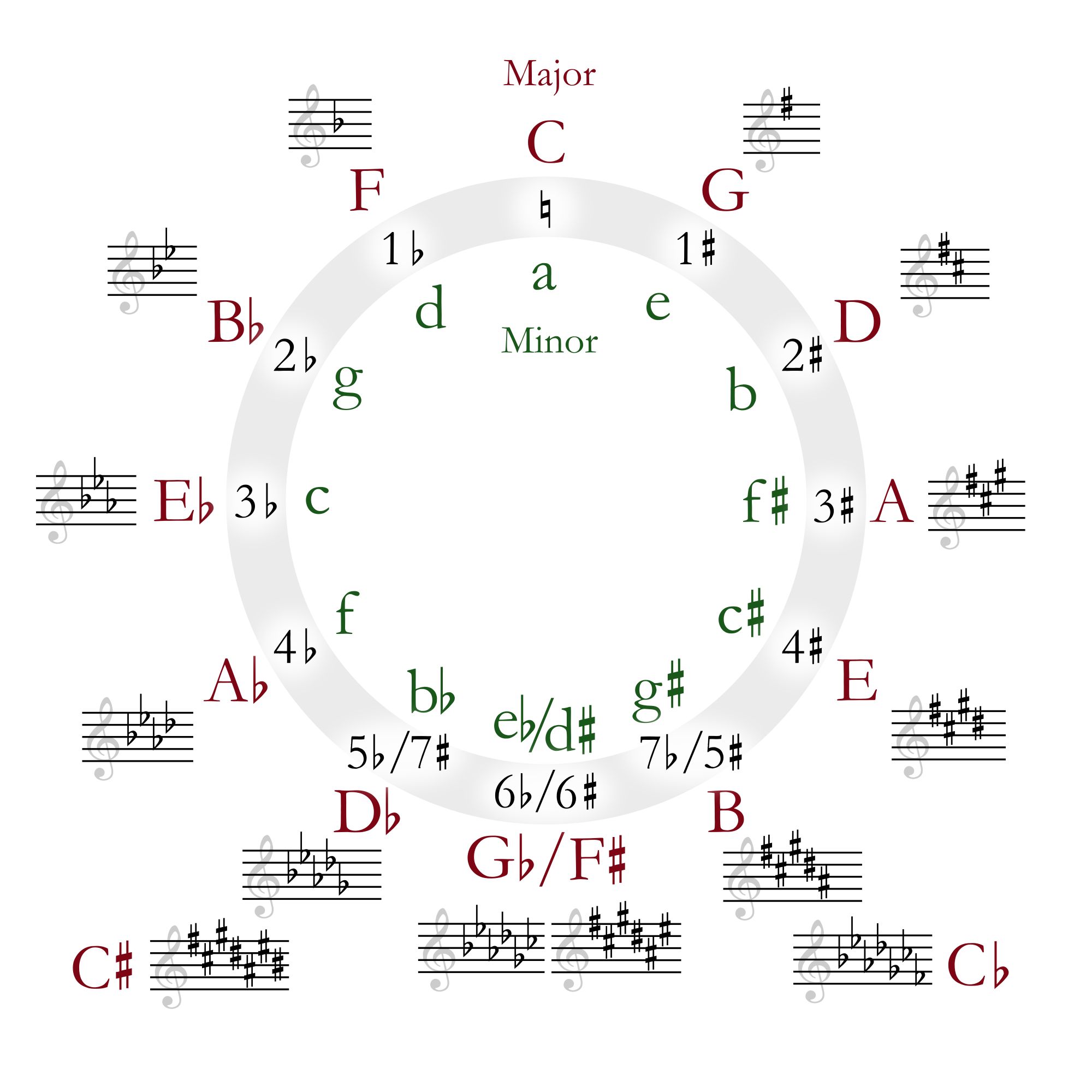Prepare to have your mind flipped, turned, and twisted as we delve deep into the magical world of chord inversions. From turning a simple C major into a mind-bending C major 7, to unlocking the secrets of the elusive diminished triad, chord inversions are like the wizards of the music world, casting powerful spells on your ears and brain. So grab your wand – I mean, your guitar or piano – and let’s embark on a journey to discover the transformative power of chord inversions.
Contents
Understanding the Basics of Chord Inversions
So, you think you know everything about chords, huh? Well, think again! Chord inversions are like the secret handshake of the music world – once you understand them, a whole new world of harmonic possibilities opens up before you. Strap in, folks, because we’re about to take a wild ride through the basics of chord inversions.
First things first, let’s break it down. A chord inversion is simply a different way of arranging the notes in a chord. Instead of sticking with the traditional root position, where the root note is the lowest note, inversions mix things up by putting a different note in the bass. It’s like musical musical chairs, but with a lot more complexity and a lot less physical activity.
Now, why would you want to mess with a good thing and start inverting chords? Well, for one, it adds a whole new level of interest and complexity to your music. It’s like adding a dash of paprika to a bland soup - suddenly, you’ve got a whole new flavor profile to work with. Inversions can create smooth transitions between chords, add tension and release, and generally make your music sound way cooler.
So, next time you’re noodling around on your guitar or piano, don’t be afraid to mix things up with some chord inversions. Your music will thank you, and you’ll sound like a total pro in no time. Just remember: keep it funky, keep it fresh, and keep those inversions coming!
The Role of Chord Inversions in Musical Transformation
Chord inversions, oh how mysterious and magical they can be! These sneaky little devils have the power to transform a bland, boring progression into something truly extraordinary. Picture this: you’re playing a simple C major chord on your guitar, and suddenly you decide to throw in a first inversion for a little spice. Boom, just like that, you’ve gone from vanilla ice cream to a triple chocolate fudge sundae with extra whipped cream and sprinkles on top.
But wait, there’s more! Chord inversions not only add flavor to your music, but they also help create smoother transitions between chords. No more jarring leaps from one chord to the next – with inversions, it’s like gliding effortlessly down a slip ‘n slide instead of tripping over a crack in the sidewalk.
And let’s not forget about the versatility of chord inversions. With just a few tweaks here and there, you can take a basic progression and turn it into something that sounds incredibly complex and sophisticated. It’s like dressing up a plain old potato in a tuxedo and monocle – suddenly, everyone is oohing and aahing over how fancy and refined it looks.
So next time you’re noodling around on your instrument, don’t be afraid to experiment with chord inversions. Who knows, you might just stumble upon a musical transformation that leaves everyone in awe of your genius. Just remember to tip your hat and graciously accept all the accolades that come your way. After all, you’re now a chord inversion wizard, and the world is your enchanted kingdom.

harmony-and-melody“>Analyzing the Impact of Inversions on Harmony and Melody
When it comes to , it’s like trying to solve a musical Rubik’s cube. Inversions are like the rebellious teenagers of the music world – they shake things up, turn things upside down, and make you question everything you thought you knew about chords and scales.
Harmony becomes a rollercoaster ride of emotions with inversions thrown into the mix. Suddenly, that once familiar major chord sounds like it’s gone through a funhouse mirror. It’s disorienting, intriguing, and downright addicting. Inversions add that spicy kick to a bland musical soup, making listeners sit up and take notice.
And let’s not forget about melody. Inversions can take a simple, straightforward melody and twist it into a pretzel of musical goodness. The notes dance around each other in unexpected ways, creating tension and release that keeps listeners on the edge of their seats. It’s like a musical game of cat and mouse, where you never know where the next note will lead.
So, embrace the chaos that inversions bring to harmony and melody. Let your ears be delighted by the unexpected twists and turns. And remember, in the crazy world of music theory, anything is possible – especially when inversions are in the mix.

Exploring Chord Inversions Across Different Musical Genres
Chord inversions are like the quirky relatives at a family reunion – they may not always be in the spotlight, but they bring a unique flair to the musical party. And just like how your crazy uncle might suddenly break out into a disco dance, chord inversions can surprise you with their versatility across different musical genres.
From the smooth jazz vibes of a II-V-I progression to the hair-raising tension of a diminished chord in a horror movie soundtrack, chord inversions play a key role in shaping the emotional landscape of a musical piece. Just when you think you’ve got them all figured out, a pop song comes along with a sneaky first inversion chord that catches you off guard.
Rock music loves to throw in some power chords for that extra punch, but don’t be fooled – even in this headbanging genre, chord inversions can have a soft side. Who would have thought that a gentle sus4 chord could make its way into a heavy metal anthem, bringing a touch of elegance to the mosh pit?
So next time you’re jamming out to your favorite tunes, take a moment to appreciate the unsung heroes of chord inversions. They may not always be in the spotlight, but they’re working behind the scenes to keep the musical party interesting across all genres. And hey, who knows – maybe they’ll even inspire you to bust out a few dance moves of your own!

reharmonization-using-chord-inversions”>Advanced Techniques: Reharmonization Using Chord Inversions
Have you ever wanted to spice up your chord progressions with some advanced techniques? Look no further than reharmonization using chord inversions! This technique allows you to add depth and complexity to your music by rearranging the notes in a chord to create a new harmonic structure.
By experimenting with different inversions, you can create unique and unexpected chord progressions that will impress your audience. Plus, it’s a great way to challenge yourself and expand your musical skills. So grab your instrument and get ready to take your playing to the next level!
With reharmonization, the possibilities are endless. You can create smooth transitions between chords, add tension and resolution to your music, and even experiment with unconventional harmonies. Don’t be afraid to think outside the box and try out new combinations. Who knows, you might just stumble upon your next musical masterpiece!
So why settle for boring old chord progressions when you can elevate your music with reharmonization using chord inversions? Get ready to wow your audience and take your playing to new heights. The sky’s the limit when it comes to exploring the world of harmonics!
The Creative Possibilities Unleashed by Mastering Chord Inversions
So, you’ve finally mastered chord inversions. Congratulations! You might be thinking, “Now what? What can I possibly do with this newfound skill?” Well, let me tell you, the creative possibilities are truly endless. Here are just a few ways you can unleash your chord inversion prowess:
- Experiment with different combinations of inversions to create unique and interesting chord progressions that will surprise and delight your listeners.
- Use inversions to spice up your chord voicings in ways you never thought possible. Who knew that a simple C major chord could sound so complex and intriguing?
- Impress your friends and family with your ability to effortlessly navigate the fretboard and play chords in ways that seem almost magical.
With chord inversions at your fingertips, you have the power to take your music to new and exciting heights. Embrace the freedom that comes with knowing you can create beautiful, complex harmonies that will leave your audience in awe. So go ahead, let your creativity run wild and see where these inversions can take you. The possibilities are truly endless!
FAQs
What are chord inversions and why are they important?
Chord inversions are like shape-shifting for music. They take the same basic chord and rearrange the notes to create a whole new sound. It’s like getting a musical makeover!
How can chord inversions transform a simple chord progression?
Think of chord inversions as adding a little spice to your musical dish. By switching up the order of the notes in a chord, you can create a more interesting and dynamic sound. It’s like adding a sprinkle of paprika to your bland mashed potatoes.
Can chord inversions make a song more emotionally powerful?
Absolutely! By using chord inversions, you can add depth and emotion to your music. It’s like painting with a wider palette of colors – you can create a richer, more textured sound that tugs at the heartstrings.
How can beginners start incorporating chord inversions into their playing?
Start by mastering the basic chord shapes, and then experiment with different inversions to see how they change the feel of a song. It’s like learning how to walk before you can run – except in this case, you’re dancing to a whole new beat!
Are there any common misconceptions about chord inversions?
One common misconception is that chord inversions are only for advanced musicians. In reality, anyone can learn to use them to elevate their music. It’s like thinking you need to be a gourmet chef to cook a delicious meal - with a little practice, anyone can do it!
Unleash your inner chord ninja!
So there you have it, folks. Chord inversions may sound fancy and intimidating, but once you dive in and start exploring their transformative power, you’ll be amazed at the sonic sorcery you can unleash. Before you know it, you’ll be flipping those chords upside down and inside out like a musical Houdini. So go forth, experiment, and let the power of chord inversions take your music to new heights. Remember, with great power comes great musical responsibility. Rock on!



